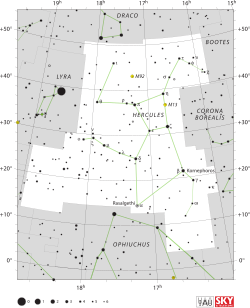Gamma Herculis
| Observation data Epoch J2000 Equinox J2000 |
|
|---|---|
| Constellation | Hercules |
| Right ascension | 16h 21m 55.21440s |
| Declination | +19° 09′ 11.2618″ |
| Apparent magnitude (V) | +3.75 |
| Characteristics | |
| Spectral type | A9 III |
| U−B color index | +0.18 |
| B−V color index | +0.27 |
| Variable type | SRd? |
| Astrometry | |
| Radial velocity (Rv) | –35.3 km/s |
| Proper motion (μ) |
RA: –47.39 mas/yr Dec.: +43.81 mas/yr |
| Parallax (π) | 16.93 ± 0.22mas |
| Distance | 193 ± 3 ly (59.1 ± 0.8 pc) |
| Details | |
| Radius | 6 R☉ |
| Surface gravity (log g) | 3.3 cgs |
| Temperature | 7,031 K |
| Rotational velocity (v sin i) | 135 km/s |
| Other designations | |
| Database references | |
| SIMBAD | data |
Gamma Herculis (γ Herculis, γ Her) is a magnitude 3.74 binary star system in the northern constellation of Hercules.
This is known to be a spectroscopic binary system, although there is no information about the secondary component. Based upon parallax measurements, this system is located at a distance of about 193 light-years (59 parsecs) from the Earth. The spectrum of the primary star matches a stellar classification of A9III, which indicates this is a giant star that has exhausted the hydrogen at its core and evolved away from the main sequence. The effective temperature is about 7,031 K, giving the star a white hue characteristic of A-type stars. It is rotating rapidly with a projected rotational velocity of 135 km s−1. The interferometry-measured angular diameter of this star is 0.95 ± 0.04 mas, which, at its estimated distance, equates to a physical radius of about six times the radius of the Sun.
Observations by German astronomer Ernst Zinner in 1929 gave indications that this may be a variable star. It was listed in the New Catalogue of Suspected Variable Stars (1981) with a magnitude range of 3.74 to 3.81. Further observations up to 1991 showed a pattern of small, slow variations with a magnitude variation of 0.05. These appeared to repeat semi-regularly with a period of 183.6 days, although the spectroscopic data presented a longer period of 165.9 days.
...
Wikipedia

